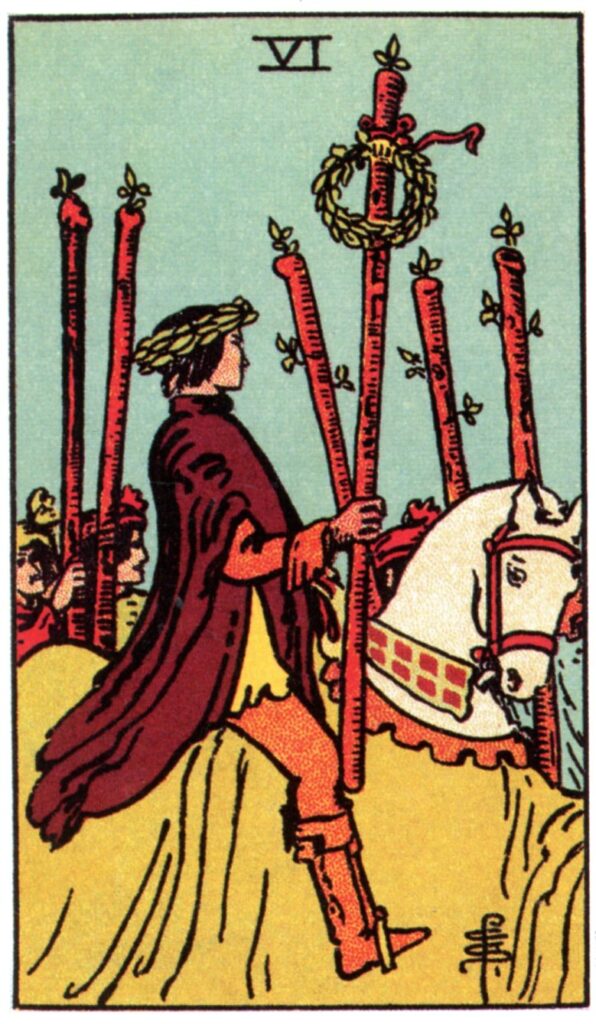When a person ends a difficult day and draws the Six of Wands, the first reaction is often confusion. How can a card of victory appear when the mood has fallen into defeat? The answer lies in understanding what kind of victory the symbol represents. It does not describe success in ordinary terms, but the endurance of the inner flame when the surface seems broken. The image belongs to the path of fire, and fire reveals truth through persistence rather than comfort. The Six of Wands reflects the secret survival of Spirit beneath material fatigue. It shows that the divine axis has held firm, even when the emotions and the body could not.
I. Tifereth in Atziluth
In the Tree of Life, the Six of Wands corresponds to Tifereth in the world of Atziluth. Tifereth is the centre of beauty and balance, the heart of the Tree. Atziluth is the world of pure fire, the first emanation where Divine Will exists before form. Tifereth in Atziluth is the Logos in its radiant state, where the Word creates through being. The sun in this sphere shines by its own nature. When this force enters the human world, it does so through veils that reduce its intensity. Passing through the worlds of Briah and Yetzirah, it becomes idea and breath, until it reaches Assiah, the world of action. The card that appears in the hands of the weary person is the final reflection of that descent. It signals that the fire has crossed all planes and still burns within matter.
In its pure source the Six of Wands is the Divine affirmation that creation has meaning. It represents harmony restored after conflict, Light reclaimed after eclipse. The original fire has not been extinguished, entering density and surviving the passage. The card points to a hidden alignment between the human act and the solar principle. It affirms that the order of beauty remains even when the senses cannot perceive it.
II. The Descent through the Worlds
Drawing a card is an act that connects the visible to the invisible, the above and the below. When the Six of Wands emerges after a day of failure, it means that the higher fire has found a vessel that did not break. The person may feel defeated, but the image declares that the will to continue is itself a victory of the Spirit. The gesture of drawing becomes a sign that the conduit is still open between the centre above and the heart below.
The figure shown on the card is often crowned with laurels, returning from battle. In the deeper reading, this is not triumphal pride but Spiritual coherence. The victory parade is inward; the true conquest is the preservation of faith through exhaustion. The Six of Wands speaks of the human faculty that holds to meaning when appearances collapse. It says that the act of perseverance is participation in the Divine order.

The fire of Tifereth is ontological endurance. It is the sun that rises after the longest night because rising is its nature. The card therefore does not promise that external conditions will improve, but that the principle of Light remains active within them. It is linked to the second decan of Leo, the fixed fire ruled by the Sun, where constancy and radiance meet. Its angelic correspondences are Sitael and Elemiah, two of the Seraphim, the order that dwells nearest to the Throne of God, whose task is to sustain creation through perpetual adoration. Leo itself is traditionally associated with the fifth house of the zodiac, the house of Good Fortune, where the soul learns to express Divine vitality through joy, creativity, and the generous sharing of inner Light.
III. Reflection in Matter
In the material plane, the light of Atziluth arrives in fragments. It takes the form of small acts that keep coherence alive. The Six of Wands in daily life can appear through a word said in honesty, a task endured without resentment, or a quiet decision to remain faithful to the work at hand. These gestures, although minor on the surface, echo the structure of the higher fire. When the will aligns with truth, the same pattern that governs the sun governs the human day.
The card reminds the reader that the victory it shows is the simple continuation of being when the impulse to withdraw feels stronger. This endurance is the earthly reflection of Tifereth in Atziluth. The Light asks to be carried through fatigue. The moment that fire re-enters matter through consciousness, the cycle of redemption renews itself.
To see the Six of Wands after hardship is to understand that defeat in appearance may conceal alignment in essence. The Divine Will has moved through the day’s disorder and kept the flame intact. What seemed wasted time becomes participation in a larger harmony. The tired hands that drew the card have, without realising, performed the act that keeps the world connected to its source.
The Six of Wands teaches that the Divine Light does not abandon the physical plane; it hides within it until recognised. The fire of Atziluth continues to burn through the ashes of experience. In this sense, Victory is the quiet endurance of meaning within matter. The card is the witness that the Word still breathes through the dust.
Κύριε ελέησον
